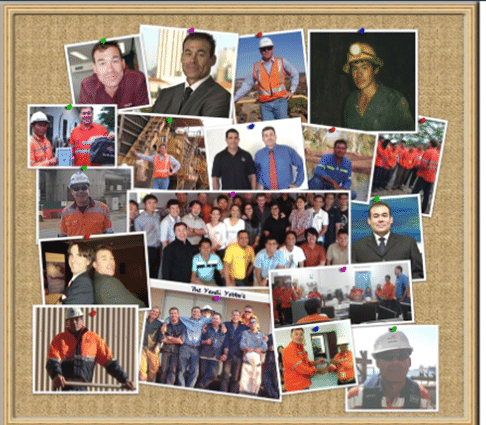HSE Trip Down Memory Lane
by Ken R. Roberts – First published here

Over the years unfortunately, apart from a few upgrades and innovation from the companies that could afford it, HSE techniques haven’t changed much. The mandatory requirement that every commercial entity implement a HSE Management System and Risk Management strategy – has created the carbon copy HSE phenomena.
In 36 years of heavy industrial mining and construction I see the same systems regurgitated over and over again. Anywhere between 12 to 15 Management Standards, filtered down into endless streams of Standards, Policies, Procedures, Guidelines, and Manuals, that frankly, very few of the actual workforce ever get to absorb or understand.
What year is it ?
Much of any HSE Management System that a worker receives is during training. Capped off with multiple choices questions and a signature to indemnify the employer. I’m trying very hard not to sound cynical here, just stating things how they are and how it’s always been since the introduction of tougher penalties. And it traces all the way back to the 1974 HSE legislation where more harsher penalties were introduced to employers who had accidents in the workplace.
One of my future projects is to look at the role legislation, with it’s ever increasing punitive demands, is a cause for detachment between workplace safety demands and corporate’s requirements. But thats fodder for another article.
Mind you, in 1974 it was a good thing at the time. The Employer was obliged to ensure they met legislation by introducing the notion of Duty of Care. For both sides, worker and employer. It’s just that it’s now 2017 right? We are now in the information age. We’ve absorbed the punitive intentions the legislation implied, so now lets move on. Now is a time we could tone down the verbose written safety procedure. We could be less indemnity driven and more purpose driven with our new technology. We have video, social media and a host of education suites available. What’s more, almost 100% of the western workforce has access to mobile or desktop technology in the home and right there with them at work on their smart phones.
There’s an App for That
I think where most HSE systems fail businesses today is that they are based on models created during the rise of the industrial revolution and the introduction of the 1974 HSE legislation. Because most systems are carbon copies they haven’t really taken full stock of the technologically driven information era we are now very much in. Unfortunately, current HSE models taught by the institutions only prepare aspirants in part for the latest trend sweeping the workforce. That is… people’s higher individual and social need for personal recognition.
Facebook and social media is teaching us that workers have much more say than they had previously. Pretty soon they will demand more recognition of their needs because of the pressure they can apply to a brands image, thus commercial success. Don’t underestimate the power of technological social interaction. In less than 10 years from now it will be the driving force behind every major workplace reform.
If Dr Martin Luther King can organise a rally to speak in front of half a million people with no more than the ‘grapevine’ and bill posters, imagine what he could’ve achieved with Facebook.
The point is, if piloted in the right direction, this new social phenomena can create enormous change in that of itself for your organisation. This type of engagement is having a massive impact everywhere in today’s world except the workplace. Unfortunately, companies aren’t maximising this opportunity to its full potential… yet!
Social HSE
We could organise our HSE systems like a Facebook page. We could have people comment on the effectiveness of a procedure. Or make suggestions in a company forum. Companies could create HSE management system Apps and have it mandatory for all employees to have it on their phones.
Other evergreen HSE techniques such as JSA’s and Take 5’s as the main workplace risk strategy could be innovated to include new social engineering techniques such as work task autonomy, workplace stewardship and role ownership. JSA’s and Take 5’s were great in the day. Both innovative and successful back in 1990’s. But they haven’t changed much with the workforce’s technological competence other than become more convoluted and confusing. A simple risk analysis tool has now become a complex risk ranking matrix.
Apart from the current risk tools in use, I’ve been trialling a system which facilitates a different approach altogether. More about collaboration, openness, autonomy, accountability and an individual’s ownership of their workplace. Much less about indemnity, procedure or signatures. It’s an overarching principle and not so much a tool. Giving back a sense of autonomy and power to the worker. It’s a technique that more than meets the legislative criteria and the necessary Australian Standards. And it’s been trialled successfully in the field. Yet when I field it to prospective companies, most shy away from the thought of such HSE innovation. Maybe too big a risk for companies to step out from the shadows of 1974.
About Ken
If you’re looking for a typical cookie-cutter health and safety specialist who won’t challenge the status quo, then Ken may not be the right person for your proposed workforce transformation or change process.
Creating an innovative, progressive, industry leading health and safety model requires cutting-edge human development skills combined with the latest tactical and technical HSE knowledge and experience. Allow Ken to show you how much of today’s HSE method’s are actually counterproductive to a companies goals. Mainly because what we do with the data is very counterintuitive. LTIFR’s as a measure of safety performance is not going to produce an inspiring target. A common vision and buy-in across all levels of the workforce will!
If you want a self-evolving continuous improvement HSE system through effective change management, workforce engagement and approval – your change facilitator must possess the ability to instil a vision that the workforce and management will buy into across all facets of your organisation.
Happy HSEing.



Do you have any thoughts? Please share them below